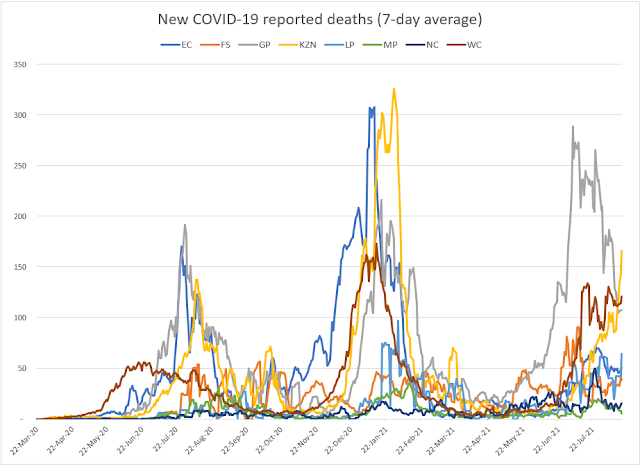Do the numbers add up?
Projections from SEIR modelling of the COVID-19 pandemic such as that using the NMG model paint a very bleak picture for South Africa. Other models can give much lower projections for infections such as that reported by the Boston Consulting Group (https://drive.google.com/Boston Consulting Group epidemic projections.pdf). This got me thinking about how wrong the SEIR model projections might be.
In an attempt to see if the numbers from the SEIR modelling add up, I took a look at the experience of Lombardy, the region in Italy that has been hardest hit by the pandemic. The graph below shows the NMG model fit to the confirmed cases reported in Lombardy since 21 February 2020.
 The growth pattern of the reported cases starts off on an exponential growth curve and then flattens out from mid-March.
The growth pattern of the reported cases starts off on an exponential growth curve and then flattens out from mid-March.
By 7 April, there were just over 53 000 confirmed cases of COVID-19 in Lombardy out of a total population of 10 million. According the NMG model, 97% of the population has not been infected and is therefore still susceptible to the disease. According to the model, relaxation of the lockdown conditions would spark off another outbreak in infections.
But is this indeed the case?
The NMG model calibration makes certain assumptions about the proportion of those infected who are asymptomatic and largely unaware that they have contracted COVID-19. But what if this proportion was much much higher in reality? The table below sets out the results of three extrapolations from the experience reported for Lombardy:
The first extrapolation represents the output from the NMG model when fit to the Lombardy experience. In terms of these numbers, only 3% of the population in Lombardy has been or is currently infected. Extrapolation 2 is one derived from the reported deaths only (ignoring the confirmed cases). In terms of this extrapolation, some 27% of the population has been or is infected. The final extrapolation uses the reported deaths together with an assumption that 2 out of every 3 persons infected are asymptomatic. Here 57% of the population has been or is currently infected.
I hunted around for data on testing done in Lombardy, and found that antibody testing had been done in two villages. In the one village, Vo, 3% tested positive for COVID-19. This would appear to support the results from the NMG model. In the other village, Castiglione D'Adda, 60 volunteers who had made blood donations were tested and 40 of these tested positive. Twitter has got quite excited about the results from Castiglione D'Adda as it would appear to imply that a majority of people have already been infected and probably built up immunity.
All I could conclude from this is that we really don't yet know how this pandemic is going to pan out in South Africa (or anywhere else). Until we get information that supports an alternative view, it is safest to plan using the pessimistic forecasts.
8 April 2020
In an attempt to see if the numbers from the SEIR modelling add up, I took a look at the experience of Lombardy, the region in Italy that has been hardest hit by the pandemic. The graph below shows the NMG model fit to the confirmed cases reported in Lombardy since 21 February 2020.
 The growth pattern of the reported cases starts off on an exponential growth curve and then flattens out from mid-March.
The growth pattern of the reported cases starts off on an exponential growth curve and then flattens out from mid-March.By 7 April, there were just over 53 000 confirmed cases of COVID-19 in Lombardy out of a total population of 10 million. According the NMG model, 97% of the population has not been infected and is therefore still susceptible to the disease. According to the model, relaxation of the lockdown conditions would spark off another outbreak in infections.
But is this indeed the case?
The NMG model calibration makes certain assumptions about the proportion of those infected who are asymptomatic and largely unaware that they have contracted COVID-19. But what if this proportion was much much higher in reality? The table below sets out the results of three extrapolations from the experience reported for Lombardy:
The first extrapolation represents the output from the NMG model when fit to the Lombardy experience. In terms of these numbers, only 3% of the population in Lombardy has been or is currently infected. Extrapolation 2 is one derived from the reported deaths only (ignoring the confirmed cases). In terms of this extrapolation, some 27% of the population has been or is infected. The final extrapolation uses the reported deaths together with an assumption that 2 out of every 3 persons infected are asymptomatic. Here 57% of the population has been or is currently infected.
I hunted around for data on testing done in Lombardy, and found that antibody testing had been done in two villages. In the one village, Vo, 3% tested positive for COVID-19. This would appear to support the results from the NMG model. In the other village, Castiglione D'Adda, 60 volunteers who had made blood donations were tested and 40 of these tested positive. Twitter has got quite excited about the results from Castiglione D'Adda as it would appear to imply that a majority of people have already been infected and probably built up immunity.
All I could conclude from this is that we really don't yet know how this pandemic is going to pan out in South Africa (or anywhere else). Until we get information that supports an alternative view, it is safest to plan using the pessimistic forecasts.
8 April 2020




This was my one of my scenario's also, that there was a significant herd immunity built up quietly in the background. Such would explain the rapid tail-off in infections and deaths recorded in Hubei, China.
ReplyDeletePart of the difficulty in understanding the epidemic is that the only relaible test we have is the PCR which identifies viral RNA (during multiplying viremia, or during the recovery stage when they might be remnants of viral RNA), but we do not have reliable antibody tests. Such antibody IgG tests would have informed us of immune people.
Thanks Jim. The scenario that the disease progression in South Africa is building up a large number of lives with immunity because they contracted the virus but did not show any symptoms must be carefully watched. If it happens then we will be able to go back to normality far sooner.
ReplyDeleteGary a very interesting article. Please continue to model and communicate what your findings are. We do need to understand how this pandemic will pan out.
ReplyDelete